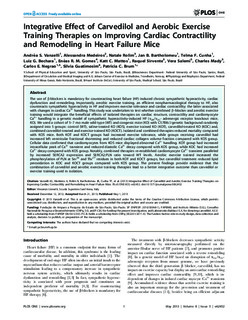| dc.contributor.author | Vanzelli, Andréa S. | |
| dc.contributor.author | Medeiros, Alessandra | |
| dc.contributor.author | Rolim, Natale Pinheiro Lage | |
| dc.contributor.author | Bartholomeu, Jan B. | |
| dc.contributor.author | Cunha, Telma F. | |
| dc.contributor.author | Bechara, Luiz G. | |
| dc.contributor.author | Gomes, Enéas R.M. | |
| dc.contributor.author | Mattos, Katt C. | |
| dc.contributor.author | Sirvente, Raquel | |
| dc.contributor.author | Salemi, Vera | |
| dc.contributor.author | Mady, Charles | |
| dc.contributor.author | Negrao, Carlos E. | |
| dc.contributor.author | Guatimosim, Silvia | |
| dc.contributor.author | Brum, Patricia C. | |
| dc.date.accessioned | 2015-11-16T13:59:44Z | |
| dc.date.accessioned | 2015-11-17T08:19:00Z | |
| dc.date.available | 2015-11-16T13:59:44Z | |
| dc.date.available | 2015-11-17T08:19:00Z | |
| dc.date.issued | 2013 | |
| dc.identifier.citation | PLoS ONE 2013, 8(5) | nb_NO |
| dc.identifier.issn | 1932-6203 | |
| dc.identifier.uri | http://hdl.handle.net/11250/2360499 | |
| dc.description.abstract | The use of β-blockers is mandatory for counteracting heart failure (HF)-induced chronic sympathetic hyperactivity, cardiac dysfunction and remodeling. Importantly, aerobic exercise training, an efficient nonpharmacological therapy to HF, also counteracts sympathetic hyperactivity in HF and improves exercise tolerance and cardiac contractility; the latter associated with changes in cardiac Ca2+ handling. This study was undertaken to test whether combined β–blocker and aerobic exercise training would integrate the beneficial effects of isolated therapies on cardiac structure, contractility and cardiomyocyte Ca2+ handling in a genetic model of sympathetic hyperactivity-induced HF (α2A/α2C- adrenergic receptor knockout mice, KO). We used a cohort of 5–7 mo male wild-type (WT) and congenic mice (KO) with C57Bl6/J genetic background randomly assigned into 5 groups: control (WT), saline-treated KO (KOS), exercise trained KO (KOT), carvedilol-treated KO (KOC) and, combined carvedilol-treated and exercise-trained KO (KOCT). Isolated and combined therapies reduced mortality compared with KOS mice. Both KOT and KOCT groups had increased exercise tolerance, while groups receiving carvedilol had increased left ventricular fractional shortening and reduced cardiac collagen volume fraction compared with KOS group. Cellular data confirmed that cardiomyocytes from KOS mice displayed abnormal Ca2+ handling. KOT group had increased intracellular peak of Ca2+ transient and reduced diastolic Ca2+ decay compared with KOS group, while KOC had increased Ca2+ decay compared with KOS group. Notably, combined therapies re-established cardiomyocyte Ca2+ transient paralleled by increased SERCA2 expression and SERCA2:PLN ratio toward WT levels. Aerobic exercise trained increased the phosphorylation of PLN at Ser16 and Thr17 residues in both KOT and KOCT groups, but carvedilol treatment reduced lipid peroxidation in KOC and KOCT groups compared with KOS group. The present findings provide evidence that the combination of carvedilol and aerobic exercise training therapies lead to a better integrative outcome than carvedilol or exercise training used in isolation. | nb_NO |
| dc.language.iso | eng | nb_NO |
| dc.publisher | Public Library of Science | nb_NO |
| dc.title | Integrative effect of carvedilol and aerobic exercise training therapies on improving cardiac contractility and remodeling in heart failure mice | nb_NO |
| dc.type | Journal article | nb_NO |
| dc.type | Peer reviewed | en_GB |
| dc.date.updated | 2015-11-16T13:59:44Z | |
| dc.source.volume | 8 | nb_NO |
| dc.source.journal | PLoS ONE | nb_NO |
| dc.source.issue | 5 | nb_NO |
| dc.identifier.doi | 10.1371/journal.pone.0062452 | |
| dc.identifier.cristin | 1047601 | |
| dc.description.localcode | © 2013 Vanzelli et al. This is an open-access article distributed under the terms of the Creative Commons Attribution License, which permits unrestricted use, distribution, and reproduction in any medium, provided the original author and source are credited. | nb_NO |
